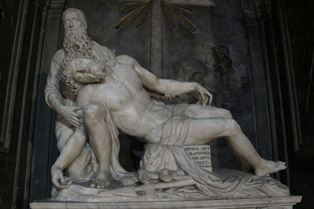
WTI Magazine #39 2014 July, 16
Author : Enrico De Iulis Translation by:
In Florence, in conjunction with the exhibition dedicated to Pontormo and Rosso Fiorentino at Palazzo Strozzi, there is also another very interesting exhibition; the one about Baccio Bandinelli. For the first time, in a comprehensive way, all the works of the Florentine sculptor are exhibited, known to history for his impossible character more than for his artistic virtues.
Bartolomeo (Baccio is a diminutive of Bartolomaccio, being "accio" a pejorative suffix of Italian grammar: just to confirm the legend about his bad attitude) was born in Florence in 1488 and his father, being a goldsmith, from an early age educates him towards the art. Baccio immediately reveals a very good skill for sculpture and an extraordinary talent for design, and so he starts to study at the workshop of Giovan Francesco Rustici, a sculptor already in full swing in the early 1500s.
Seeing young Bandinelli's preparatory drawings, Leonardo da Vinci is impressed and urges him to continue, probably giving fuel to the fire of the already not humble Baccio's character: shortly thereafter he begins to study Michelangelo's fresco of the Battle of Cascina. So, Baccio's priority becomes to imitate and exceed Buonarroti: and even competing with him for some works from the Medici family, Bandinelli does not understand his inferiority to Michelangelo's genius.
However, he is commissioned for several works by the Medici family: he serves for the two Popes of the family who take turns to the papal throne in the first half of the century.
His art engages exactly in the Florentine Mannerism in the first half of the sixteenth century: and as well as Pontormo, Rosso Fiorentino and Bronzino for painting, Bandinelli and Benvenuto Cellini are for carving the most important members of the Florentine generation that followed the way of the greats such as Michelangelo, Leonardo and Raphael.
One of the most common criticisms about Baccio's style regards the abnormal proportions and the ungainly representation of the sculptures, causing his contemporaries to consider him coarse and rough: this kind of objection always infuriates the proud and conceited artist.
His Adam and Eve, sculpted for the Cathedral of Florence is ignored by everyone, and even the Hercules and Cacus that still stands in Piazza della Signoria, has always been consider ridicule. The rough and heavy design is obviously a deliberate stylistic choice, by an artist who, instead, shows in the drawings such grace to be copied and studied by generations of Italian and European artists.
His fall into the oblivion gets definitive in the nineteenth century, when the translation of Giorgio Vasari's "Vite" (lives) is spread all over the world: Vasari is a harsh detractor of Bandinelli, many times reaching true heights of unjust partisanship in preferring his hated enemy, Cellini.
The exhibition which is currently staged at the Bargello Museum, the largest museum of sculpture of the Italian Renaissance, does justice to the author of many beautiful and strong works, and finally replaces Baccio Bandinelli in the primary circle of the artists of the Florentine mannerism, that has produced and left so much inheritance in the Italian figurative art.



